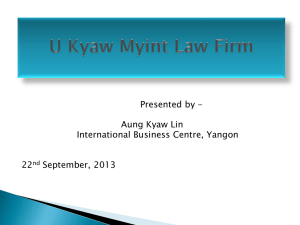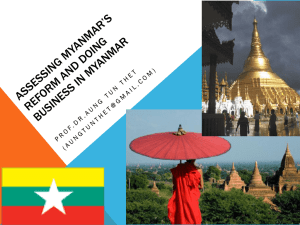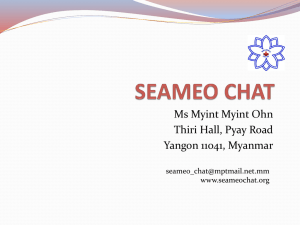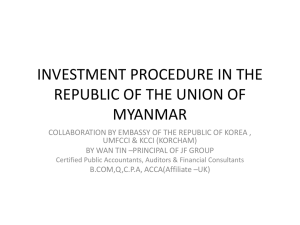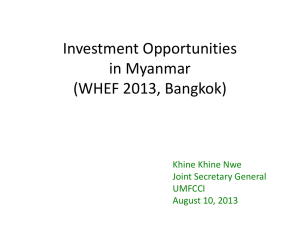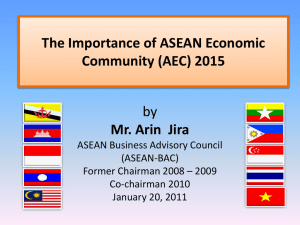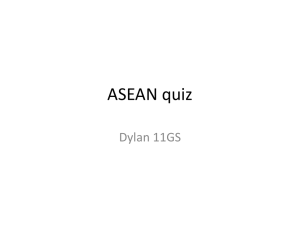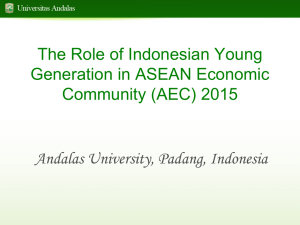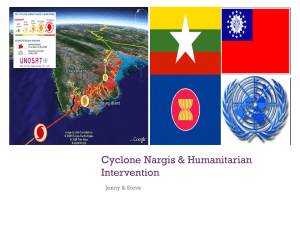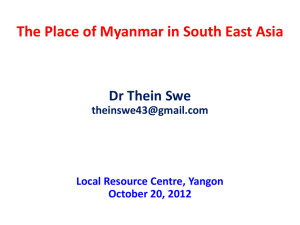Competition Policy and Law
advertisement
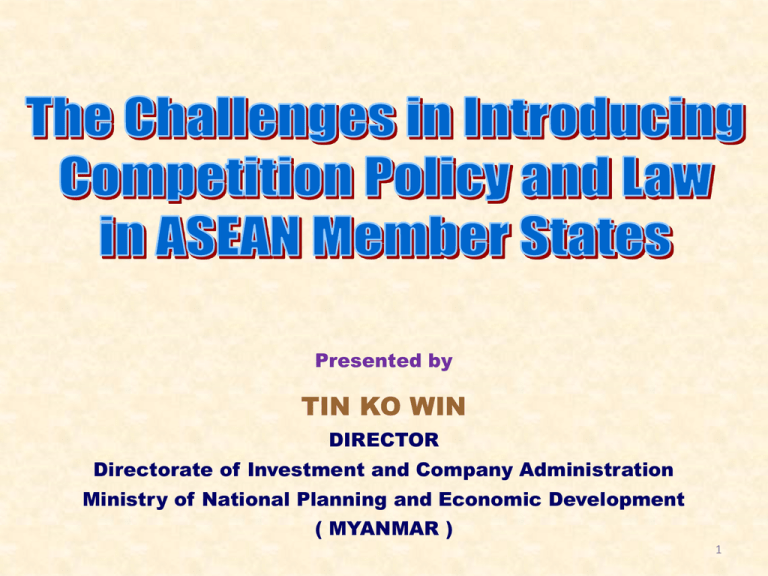
Presented by TIN KO WIN DIRECTOR Directorate of Investment and Company Administration Ministry of National Planning and Economic Development ( MYANMAR ) 1 Chairman Dear Excellencies, Distinguished Guests, Ladies and Gentlemen, “Mingalaba” and health and happiness to you all! I would like to extend my warmest greetings, wishing you all in physical and spiritual wellbeing. I have a great honour to attend the 1st ASEAN Competition Conference. Myanmar Legal System Firstly let me introduce to you the historical background of Myanmar Legal System. 2 Introduction The Union of Myanmar has a substantial, sound, solid and strongly rooted legal system. Myanmar legal system is a unique system based on the Common Law Legal System. Myanmar started to stand as a sovereign state practicing Parliamentary Democracy in 1948. But a centralized planed economy was adopted under a policy called “the Burmese Way to socialism” in 1962 . 3 After the State Law and Order Restoration Council (referred to as the State Peace and Development Council) took over the responsibilities of the State on 18th September 1988. Myanmar Economic System has changed from the Centralized Economic System to the Market-oriented Economic System to cope with current world situation. The Government had repealed the centrally planned economy Laws, Rules, Regulations and Procedures that are no more in line with the market - oriented economic system. And then the Government had promulgated numerous new Laws, Rules, Regulations and Procedures to sustain the country’s economic growth. 4 The Government has been striving hard to promote all round development of national economy in Myanmar. The Government has been actively encouraging foreign investment and local investment in Myanmar since 1988. Among the new laws, the Union of Myanmar Foreign Investment Law and the Myanmar Citizens Investment Law provide that rights of Trademarks, Patents and Technical know - how can be evaluated and included in investment. Competition Policy and Law The Competition Policy and Law is one of the important elements that should play an integral part in ASEAN’s regional trade liberalization and economic integration. In the AEC Blueprint, Competition Policy and Law take place an important role. Today it needs to adopt competition laws for all ASEAN member countries. 5 Myanmar is making necessary preparation to promulgate Competition Policy and Law in accordance with the provisions of new Constitution Law and her present market - oriented economic system. ASEAN Economic Community (AEC) is one of three pillars to bring about an ASEAN Community, intended to create a stable, prosperous and high competitive economic region. Myanmar will try to accommodate together with the other member countries regarding the Competition Policy and Law in ASEAN Region. Competition Policy and Law (CPL) is one of the important elements that should play an integral part in ASEAN’s regional trade liberalization and economic integration. AEC is one of three (3) pillars to bring about an ASEAN Community intended to create a stable prosperous and highly Competitive Economic Region. 6 ASEAN Expert Group on Competition (AEGC) is an effective regional competition institution which will be provided to further regional cooperation in competition development under the conditions of AEC Blueprints. Challenges in the Implementation of Competition Policy and Law Regarding to competition policy and law, in Section 36, Subsection (b) of the new Constitution of the Republic of the Union of Myanmar which has been ratified by the National Referendum “the Union shall protect and prevent acts that injure public interests through monopolization or manipulation of prices by an individual or group with intent to endanger fair competition in economic activities”. In this way, Myanmar will carry out to enact competition policy and law in near future in accordance with the provisions of the Constitution Law which is based on all existing laws and ASEAN Regional Guidelines on Competition. 7 Regarding to competition policy, Myanmar will be carried out to understand the advocacy and awareness for the people and to make the necessary arrangements for drafting. In principle, competition has a positive role to play in development. The major challenge faced by developing countries is in legislating and implementing Competition Law. It cannot succeed unless there is a social understanding of the law and acceptance of its value to development policy. Competition advocacy is the means by which the benefits of legislation are explained and disseminated through various levels of society, including the government and the judiciary. Difficulties go beyond determining the contents of the law to the problems of introducing it to stakeholders who do not understand the intent of the law and its benefits. Difficulty in getting the legislations through the legislative body (Parliament or Pyithu Hluttaw) is symptomatic of such problems. 8 Once the law is passed, there are a host of problems faced by the competition authority in establishing the institution and enforcing the law, in general, there is therefore an urgent need to engage in advocacy with stakeholders, including other public institutions, in order to build a culture of competition in the society that is receptive to and supportive of a new competition regime. Furthermore, in order to draft and enact a strong, enforceable and flexible competition law that is respectful of legal principles, institutional capacity for competition authorities much be strengthened. Competition law enforcement requires both legal and economic expertise. The law must also provide the authority with broad investigative powers, such as the power to initiate and investigation, to request information from any public or private business person, and the legal right to enter into business premises to collect information and seize documents. 9 Economic reforms and developments Well, I am going to deal with the nation's economic sector. Right now, the new government is making necessary adjustments in the public interest after reviewing financial, monetary, trade and investment policies to reform and develop the whole economic infrastructure. It is now rewriting the Investment Law to be adaptable to the advancing era and drafting a competition policy and law suitable to market economy. 10 Conclusion At present, we are preparing to enact new Competition Policy and Law and endeavouring to cooperate with the Regional Organizations and countries for the development of CPL environment. We would like to appreciate your views and suggestions on Developing Regional Guidelines on Competition Policy and Law to facilitate better preparation for a member of ASEAN. We believe that ASEAN Economic Community (AEC) is one of three pillars to bring about an ASEAN Community, intended to create a stable, prosperous and highly competitive economic region. In conclusion, we hope that an effective Competition Policy and Law will be enacted in near future in Myanmar. 11 12
